Study on Harmless Treatment and Performance of Phosphogypsum-Based Inorganic Cementing Material
Abstract
1. Introduction
2. Materials and Methodology
2.1. Materials
2.1.1. Phosphogypsum
2.1.2. Cement
2.1.3. Quicklime
2.1.4. Stabilizer
2.2. Experimental Method
2.2.1. Harmful Ion Concentration and pH Value Characterization
2.2.2. Design and Preparation of PICM
2.2.3. Compaction Parameter Characterization
2.2.4. Mechanical Performance Characterization
2.2.5. Moisture and Freezing Resistance Characterization
- = Ratio of unconfined compression strength of frost group to that of control group, %;
- Unconfined compression strength of control group, MPa;
- = Unconfined compression strength of frost group, MPa.
3. Results and Discussion
3.1. Harmful Ion Detection and Inhibition
3.1.1. Detection of Harmful Ions in Phosphogypsum
3.1.2. Inhibition of Harmful Ion Overflow in Phosphogypsum
3.2. Compaction Parameter for PICM Preparation
3.3. Mechanical Performance
3.4. XRD Analysis
3.5. Moisture and Freezing Resistance
4. Conclusions
- 1.
- Fluoride and phosphate ions were found to be potential harmful soluble substances in phosphogypsum, with concentrations in its leachate of 100.45 mg/L and 139.21 mg/L, respectively. These results were over the environmental safety upper limit of the harmful ion concentration in the phosphogypsum overflow solution, suggesting corresponding harmless treatment was required that was thought to be an essential stage before preparing PICM. In addition, the original pH value of the phosphogypsum leaching solution was 2.60. The concentration of fluoride and phosphate ions was found to be 15.31 mg/L and undetectable when 2% quicklime by mass proportion of phosphogypsum was added and mixed as a harmless treatment; meanwhile, the pH value was also raised to 9. Environmental safety through suppressing the leaching of harmful ions from the phosphogypsum-based material was, thus, achieved by adding quicklime. It also provided an alkaline environment that was positive for higher ettringite production during the curing of PICM that might lead to higher stiffness.
- 2.
- The cement content and quicklime dosage were positively correlated with PICM’s maximum dry density and negatively affected the corresponding optimum moisture content. A longer curing time would result in higher compression strength, of which PICM with 25% cement and 2.5% stabilizer presented the highest unconfined compression strength. PICM’s 28 d unconfined compression strength was generally over 30 MPa, which can meet the requirement of materials used in the affiliated facility of the highway. The corresponding flexural strength results exhibited no clear trend.
- 3.
- The main composition of PICM was quartz, gypsum, ettringite, and calcite according to XRD characterization. The quartz content decreased as the cement content and quicklime content rose. The ettringite content presented a reducing trend when the cement and quicklime content increased. The quicklime content had a negative effect on the calcite content. Developing the content of stabilizer, quicklime, and cement can enhance PICM’s freezing and moisture resistance, owing to the denser microstructure of PICM. PICM was thought to be used as material for temporary or access roads, affiliated facility and replacement of cement concrete for rural or low-grade pavement due to its adequate strength and reliable environmental innocuity.
Author Contributions
Funding
Institutional Review Board Statement
Informed Consent Statement
Data Availability Statement
Acknowledgments
Conflicts of Interest
References
- Chen, K.; Dai, S.; Li, J.; Lin, L.; Qin, W.; Gao, Y.; Hu, E.; Jiang, J. Towards circular economy: Sustainable valorization of municipal solid waste incineration fly ash for recovery of high-purity chlorides and calcium, and separation of heavy metals. Environ. Res. 2025, 277, 121536. [Google Scholar] [CrossRef]
- Gu, J.; Wei, C.; Wu, P.; Cao, Z.; Shao, Y.; Liu, X.; Zhang, Z. Application and mechanism analysis of steel slag in resource recovery and environmental remediation: A review. Miner. Eng. 2025, 227, 109268. [Google Scholar] [CrossRef]
- Murali, G.; Azab, M. Recent research in utilization of phosphogypsum as building materials: Review. J. Mater. Res. Technol. 2023, 25, 960–987. [Google Scholar] [CrossRef]
- Yue, H.; Fang, A.; Hua, S.; Gu, Z.; Jia, Y.; Yang, C. Development and Field Application of Phosphogypsum-Based Soil Subgrade Stabilizers. J. Renew. Mater. 2022, 10, 2247–2261. [Google Scholar] [CrossRef]
- Bakker, E.; Soen, H.; van Kempen, M.; van Leest, A.; van der Wegen, G.; Dehaudt, S.; Cheeseman, C. Industrial trials using the mineral fraction of municipal solid waste incinerator bottom ash as a filler in unreinforced concrete products. Prog. Eng. Sci. 2025, 2, 100055. [Google Scholar] [CrossRef]
- Yan, Y.; Zhang, W.; Li, X.; Zhu, Z.; Yang, Y.; Sui, Y.; Xu, G. Utilization of oil shale residue from Alberta Taciuk process in phosphogypsum slag cement: Compressive strength, hydration behavior, and microstructural characteristics. J. Build. Eng. 2025, 107, 112771. [Google Scholar] [CrossRef]
- Hyks, J.; Šyc, M.; Korotenko, E.; Cajthaml, T.; Semerád, J.; Hjelmar, O. Leaching of per- and polyfluoroalkyl substances (PFAS) from municipal solid waste incineration bottom ash intended for utilization as secondary aggregates in road subbase. J. Hazard. Mater. 2025, 483, 136635. [Google Scholar] [CrossRef]
- Osemudiamhen, A.E.; Ma, L.; Ngo, I.; Cao, G. Machine learning-driven strength prediction for solid waste-based backfill materials using infrared radiation indices. Infrared Phys. Technol. 2025, 149, 105898. [Google Scholar] [CrossRef]
- Xu, J.; Luo, Q.; Tang, Y.; Zeng, Z.; Liao, J. Experimental Study and Application of Controlled Low-Strength Materials in Trench Backfilling in Suqian City, China. Materials 2024, 17, 775. [Google Scholar] [CrossRef]
- Song, W.; Zha, F.; Zhu, Z.; Xu, L.; Kang, B.; Yang, J.; Pu, S. Freeze-thaw resistance and deterioration mechanism of alkali-activated filling grouts prepared from full industrial solid wastes for tunnels. Mater. Today Commun. 2024, 41, 111009. [Google Scholar] [CrossRef]
- Xu, J.; Wu, X.; Huang, H.; Mao, Y. Experimental study of the pore pressure variation during EPB shield tunnelling in the saturated sand. Tunn. Undergr. Space Technol. 2025, 161, 106576. [Google Scholar] [CrossRef]
- Wang, Y.; Zhang, X.; Su, L.; Geng, J. Study on the influence of composite modified coal gangue coarse aggregate on the mechanical properties of concrete and mesoscopic simulation. J. Build. Eng. 2025, 106, 112549. [Google Scholar] [CrossRef]
- Zhao, C.; Liang, S.; Wu, Z.; Huang, Y.; Peng, D.; Huang, T. Mechanically activated steel slag induces Ca-P crystallization to recover phosphates from phosphogypsum leachate: Adsorption and crystallization coupled processes. Colloids Surf. A Physicochem. Eng. Asp. 2025, 713, 136535. [Google Scholar] [CrossRef]
- DeWindt, M.A.; Weiksnar, K.D.; Laux, S.J.; Ferraro, C.C.; Townsend, T.G. A review of the suitability and performance of phosphogypsum as a material for road base and subbase construction. Resour. Conserv. Recycl. 2025, 215, 108120. [Google Scholar] [CrossRef]
- Men, J.; Li, Y.; Cheng, P.; Zhang, Z. Recycling phosphogypsum in road construction materials and associated environmental considerations: A review. Heliyon 2022, 8, e11518. [Google Scholar] [CrossRef]
- Millán-Becerro, R.; Pérez-López, R.; Cánovas, C.R.; Macías, F.; León, R. Phosphogypsum weathering and implications for pollutant discharge into an estuary. J. Hydrol. 2023, 617, 128943. [Google Scholar] [CrossRef]
- Geraldo, R.H.; Costa, A.R.D.; Kanai, J.; Silva, J.S.; Souza, J.D.; Andrade, H.M.C.; Gonçalves, J.P.; Fontanini, P.S.P.; Camarini, G. Calcination parameters on phosphogypsum waste recycling. Constr. Build. Mater. 2020, 256, 119406. [Google Scholar] [CrossRef]
- Qu, F.; Zhang, Y.; Li, M.; Dong, W.; Li, W.; Tsang, D.C.W. Resource recycling of industrial waste phosphogypsum in cementitious materials: Pretreatment, properties, and applications. J. Environ. Manag. 2025, 376, 124291. [Google Scholar] [CrossRef]
- Cao, W.; Yi, W.; Peng, J.; Li, J.; Yin, S. Recycling of phosphogypsum to prepare gypsum plaster: Effect of calcination temperature. J. Build. Eng. 2022, 45, 103511. [Google Scholar] [CrossRef]
- Wu, F.; Chen, B.; Qu, G.; Liu, S.; Zhao, C.; Ren, Y.; Liu, X. Harmless treatment technology of phosphogypsum: Directional stabilization of toxic and harmful substances. J. Environ. Manag. 2022, 311, 114827. [Google Scholar] [CrossRef]
- Shu, J.; Zhao, J.; Wei, X.; Chen, M.; Li, B.; Gao, Y.; Yang, Y.; Deng, Z. Synergistic harmless treatment of phosphogypsum leachate wastewater with iron-rich electrolytic manganese residue and electric field. Miner. Eng. 2023, 204, 108399. [Google Scholar] [CrossRef]
- Shi, X.; Zeng, A.; Duan, H.; Zhang, H.; Yang, J. Status and development trends of phosphogypsum utilization in China. Circ. Econ. 2024, 3, 100116. [Google Scholar] [CrossRef]
- Dutta, R.K.; Kumar, V. Suitability of Flyash-Lime-Phosphogypsum Composite in Road Pavements. Period. Polytech.-Civ. Eng. 2016, 60, 455–469. [Google Scholar] [CrossRef]
- Min, C.D.; Shi, Y.; Lu, X.Y.; Liu, Z.X.; Zhou, Y.A. Cemented backfill using Ca(OH)2-pretreated phosphogypsum as aggregate: Hydration characteristics, structural features and strength development. Constr. Build. Mater. 2023, 402, 133011. [Google Scholar] [CrossRef]
- Ou, L.; Li, R.; Zhu, H.; Zhao, H.; Chen, R. Upcycling waste phosphogypsum as an alternative filler for asphalt pavement. J. Clean. Prod. 2023, 420, 138332. [Google Scholar] [CrossRef]
- Dong, C.Y.; Xiang, H.; Hu, X.D.; Wu, H.; Gao, B.; Wan, J.M.; Rao, Z.M.Y.; Fan, Z.W.; Ma, Y. Evaluation of the Influence of Phosphogypsum-Based Composite Filler on Performance of the SMA-13 Asphalt Mixture and Its Harmless Treatment. Sustainability 2024, 16, 6613. [Google Scholar] [CrossRef]
- Fu, R.; Lu, Y.; Wang, L.; An, H.; Chen, S.; Kong, D. The effects of admixtures on the durability properties of phosphogypsum-based cementitious materials. Constr. Build. Mater. 2024, 411, 134379. [Google Scholar] [CrossRef]
- Meng, Y.; Pan, Z.; Luo, X.; Zhao, J.; Lu, T.; He, G.; Huang, J. Study on the high-temperature performance of phenol-amine co-deposited phosphogypsum whisker/SBS composite modified asphalt. Constr. Build. Mater. 2025, 464, 140076. [Google Scholar] [CrossRef]
- JTG E42-2005; Test Methods of Aggregate for High Way Engineering. Highway Research Institute of the Ministry of Transport: Beijing, China, 2005.
- GB 175-2023; Common Portland Cement. National Standardization Administration of China: Beijing, China, 2023.
- Zhou, Z.; Liu, J.; Luo, K.; Wu, A.; Wang, H. Study on Performance Regulation and Mechanism of Quicklime and Biopolymer on Hemihydrate Phosphogypsum. J. Renew. Mater. 2021, 10, 373–384. [Google Scholar] [CrossRef]
- JC/T 479-2013; Building Quicklime. Ministry of Industry and Information Technology of the People’s Republic of China: Beijing, China, 2013.
- HJ 557-2010; Solid Waste-Extraction Procedure for Leaching Toxicity-Horizontal Vibration Method. Ministry of Ecology and Environment of the People’s Republic of China: Beijing, China, 2010.
- GB/T 15555. 11-1995; Solid Waste—Determination Offluoride—Ion Selective Electrode Method. National Environmental Protection Administration, National Technical Supervision Administration: Beijing, China, 1995.
- Toualbia, Y.; Sari-Ahmed, B.; La Porta, G.; Makhlouf, A.; Ghrici, M.; Pirulli, M. Unconfined compressive strength prediction of lime-stabilised clayey soils under freeze-thaw conditions. Environ. Geotech. 2025. [Google Scholar] [CrossRef]
- JTG E51-2009; Test Methods of Materials Stabilized with Inorganic Binders for Highway Engineering. Ministry of Transport of the People’s Republic of China: Beijing, China, 2009.
- Ciaccio, J.A.; Scaramella, L.Y. Establishing the Regioselectivity of a Small-Scale Alkene Hydration Reaction Using TLC Co-spotting. J. Chem. Educ. 2024, 101, 3993–3997. [Google Scholar] [CrossRef]
- GB8978-1996; Integrated Wastewater Discharge Standard. State Bureau of Environment Protection: Beijing, China, 1996.
- Shen, W.; Zhou, M.; Ma, W.; Hu, J.; Cai, Z. Investigation on the application of steel slag–fly ash–phosphogypsum solidified material as road base material. J. Hazard. Mater. 2009, 164, 99–104. [Google Scholar] [CrossRef]
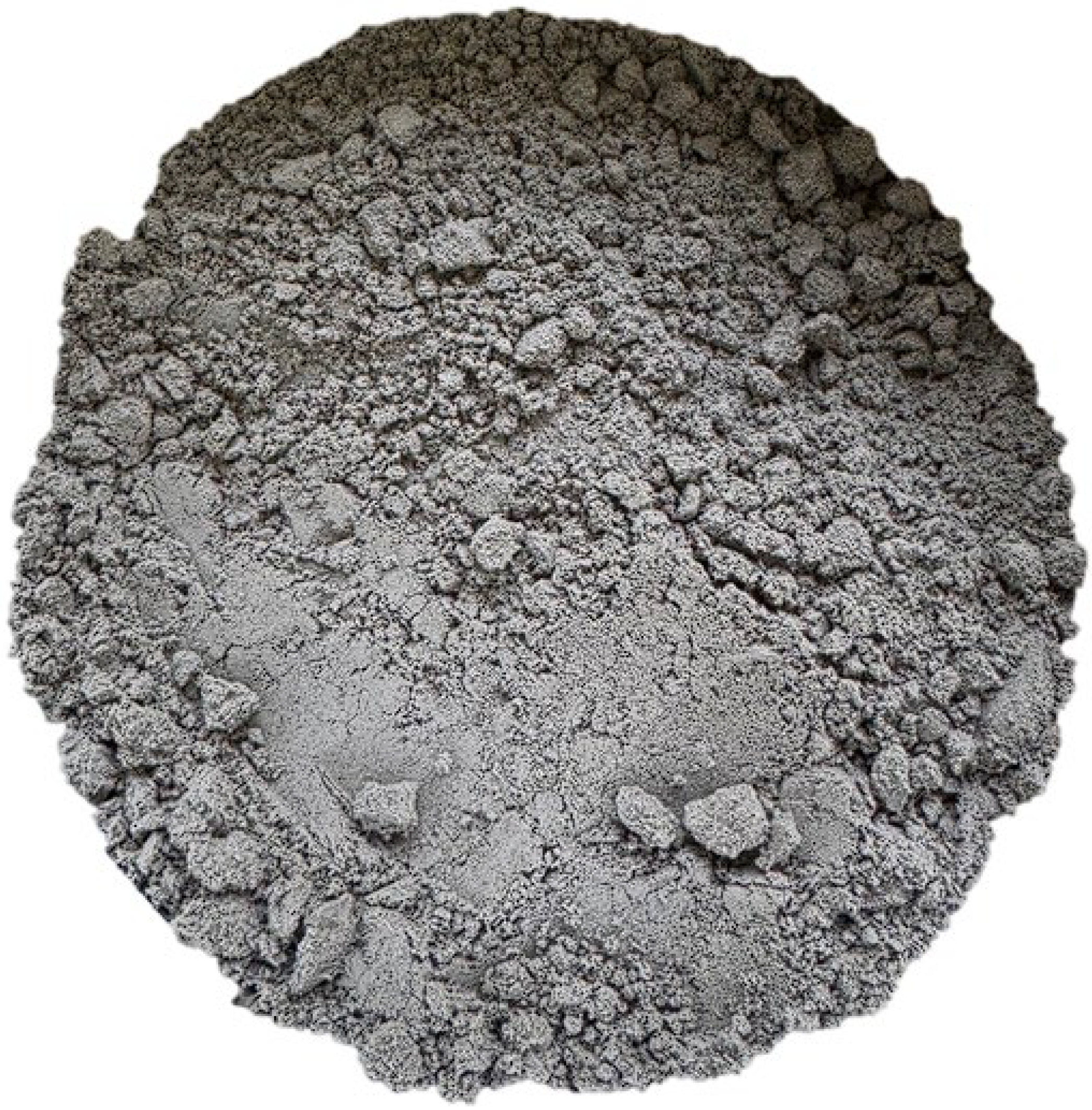
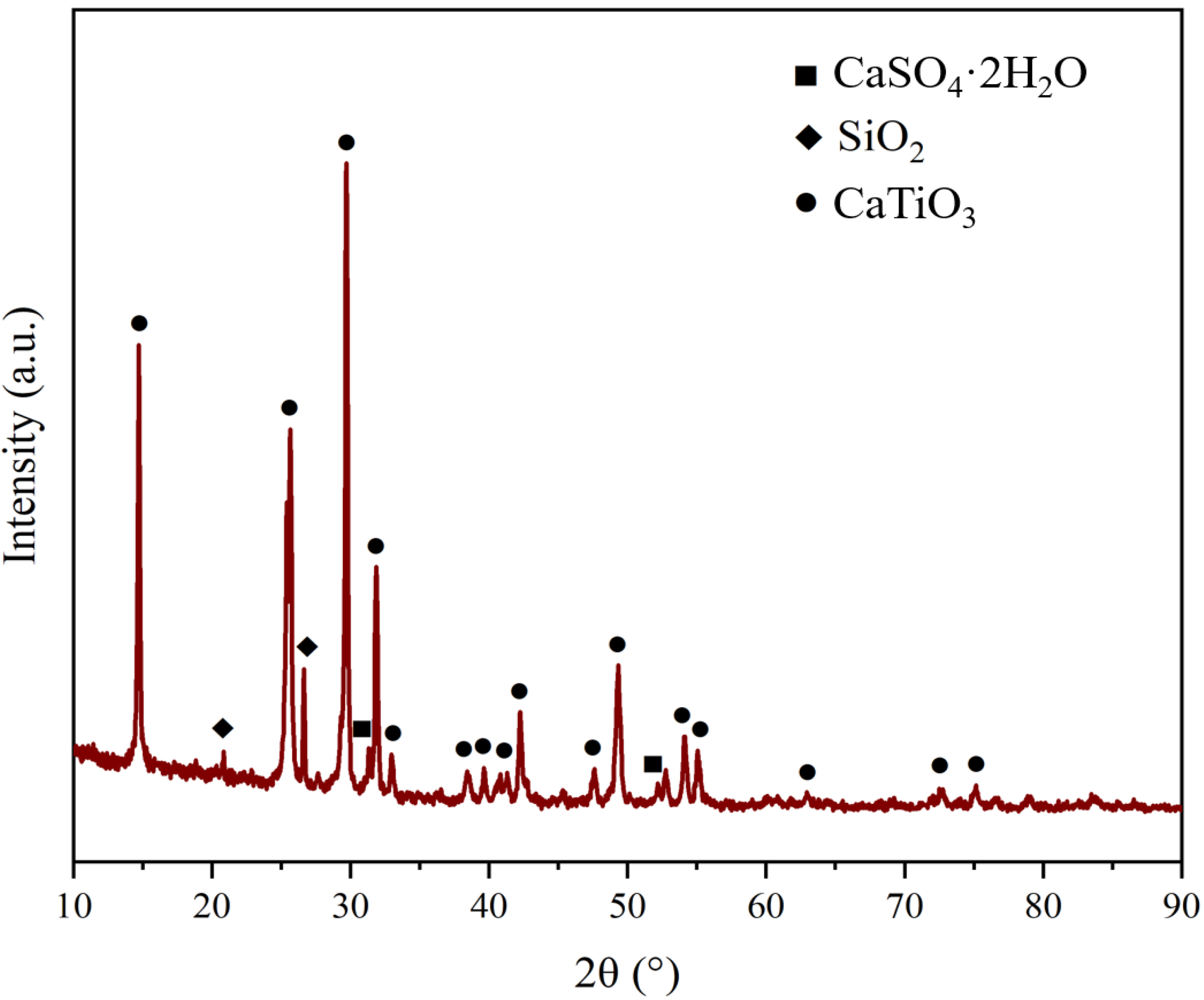
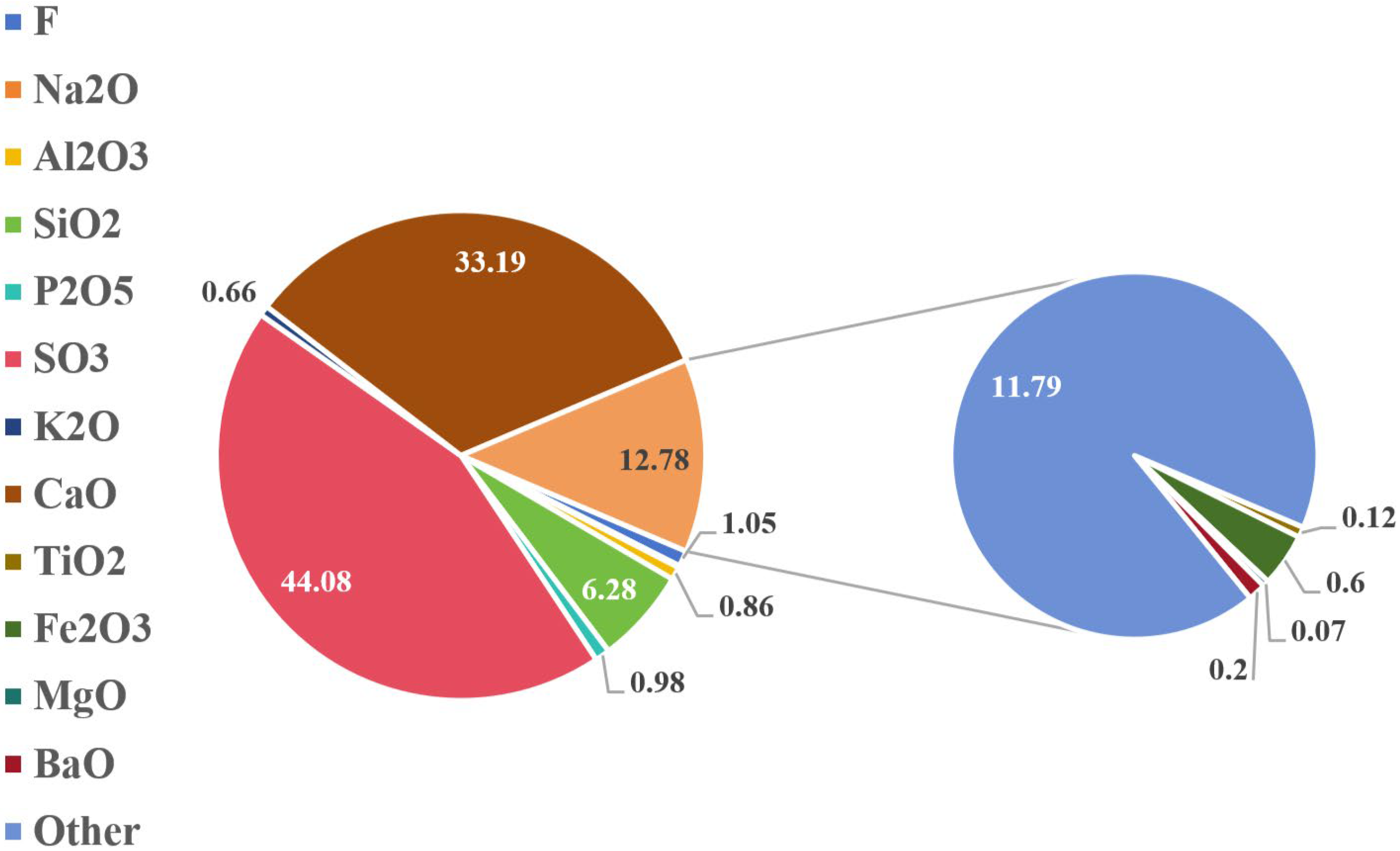
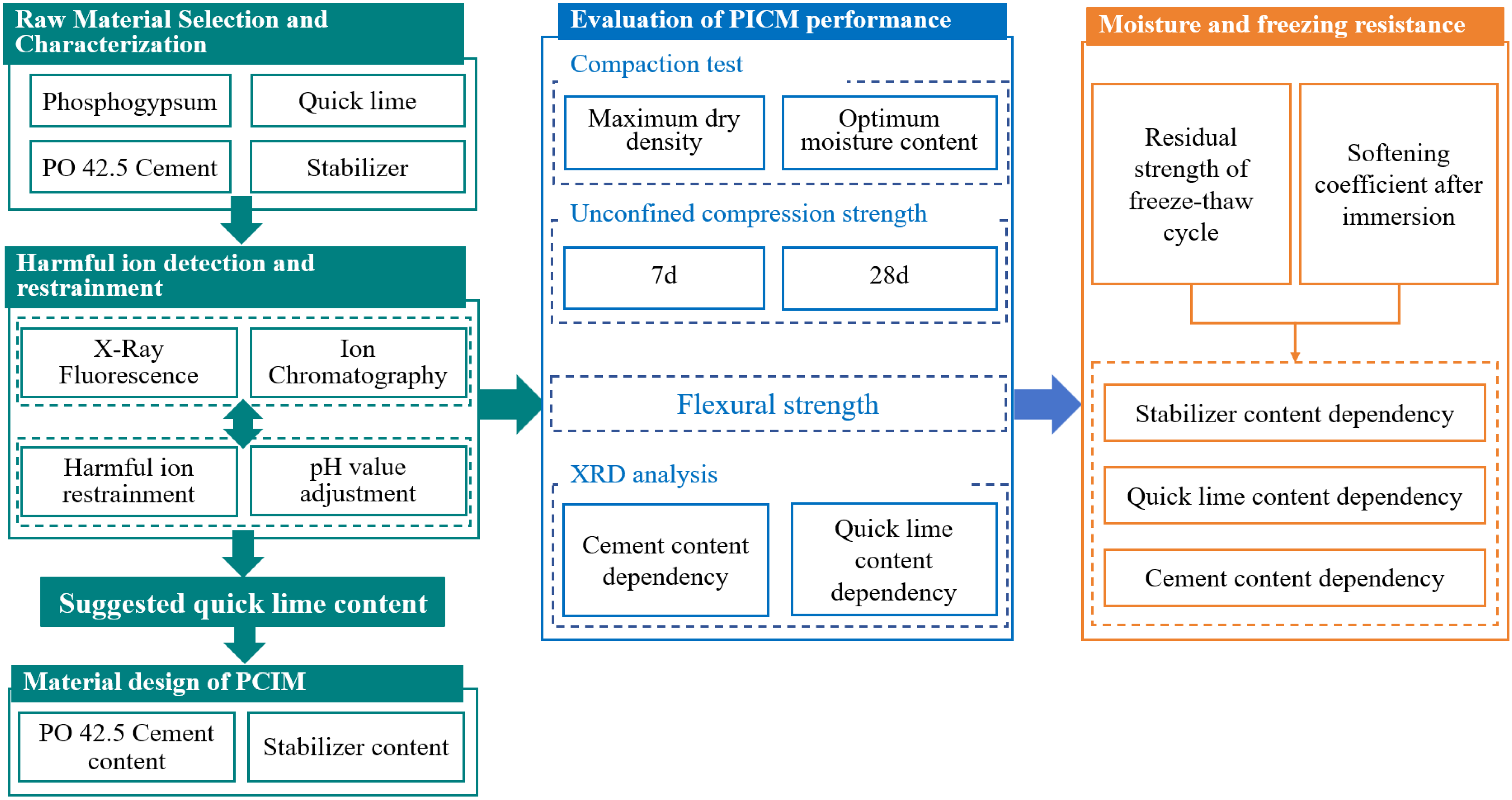
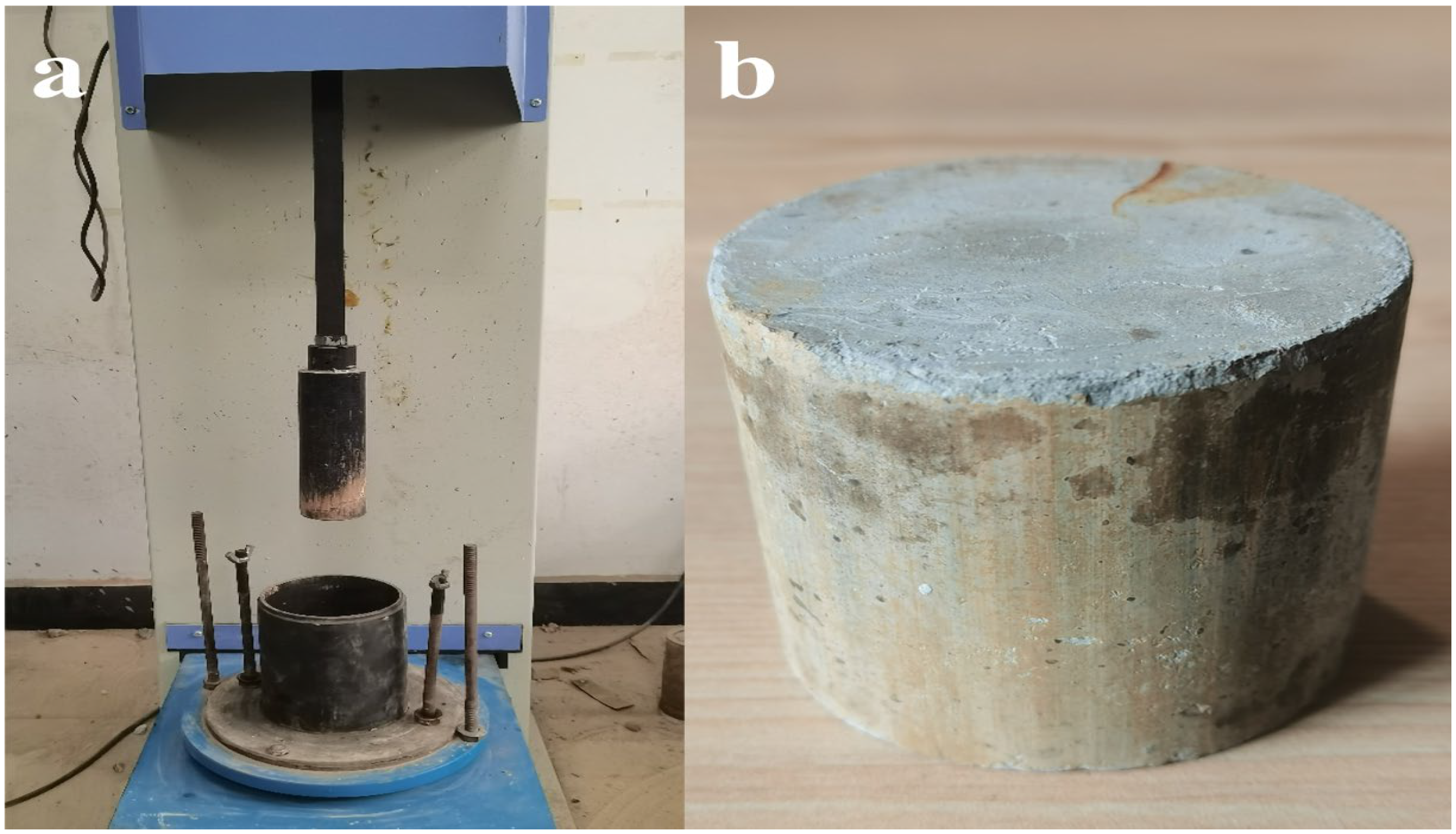
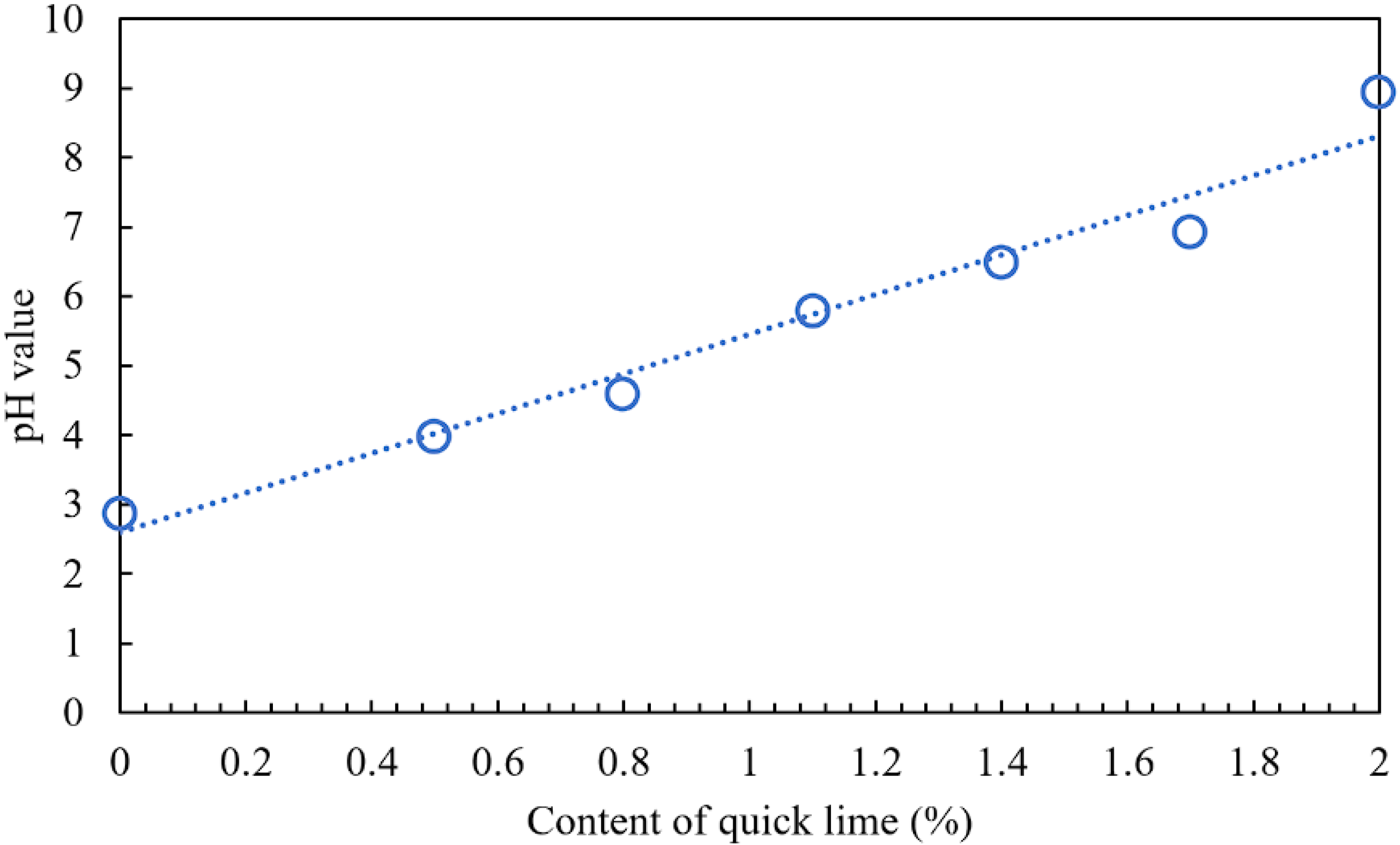
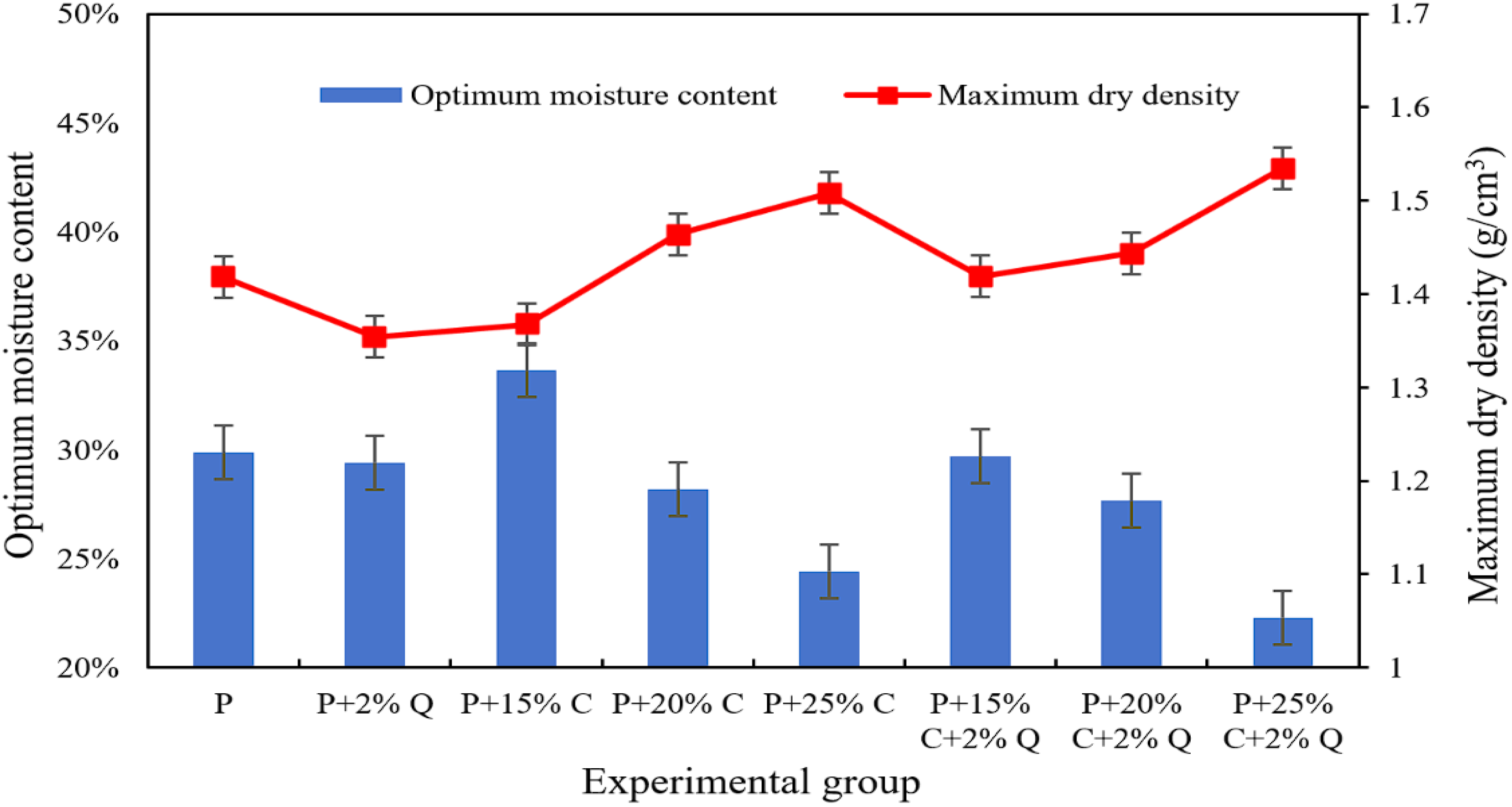
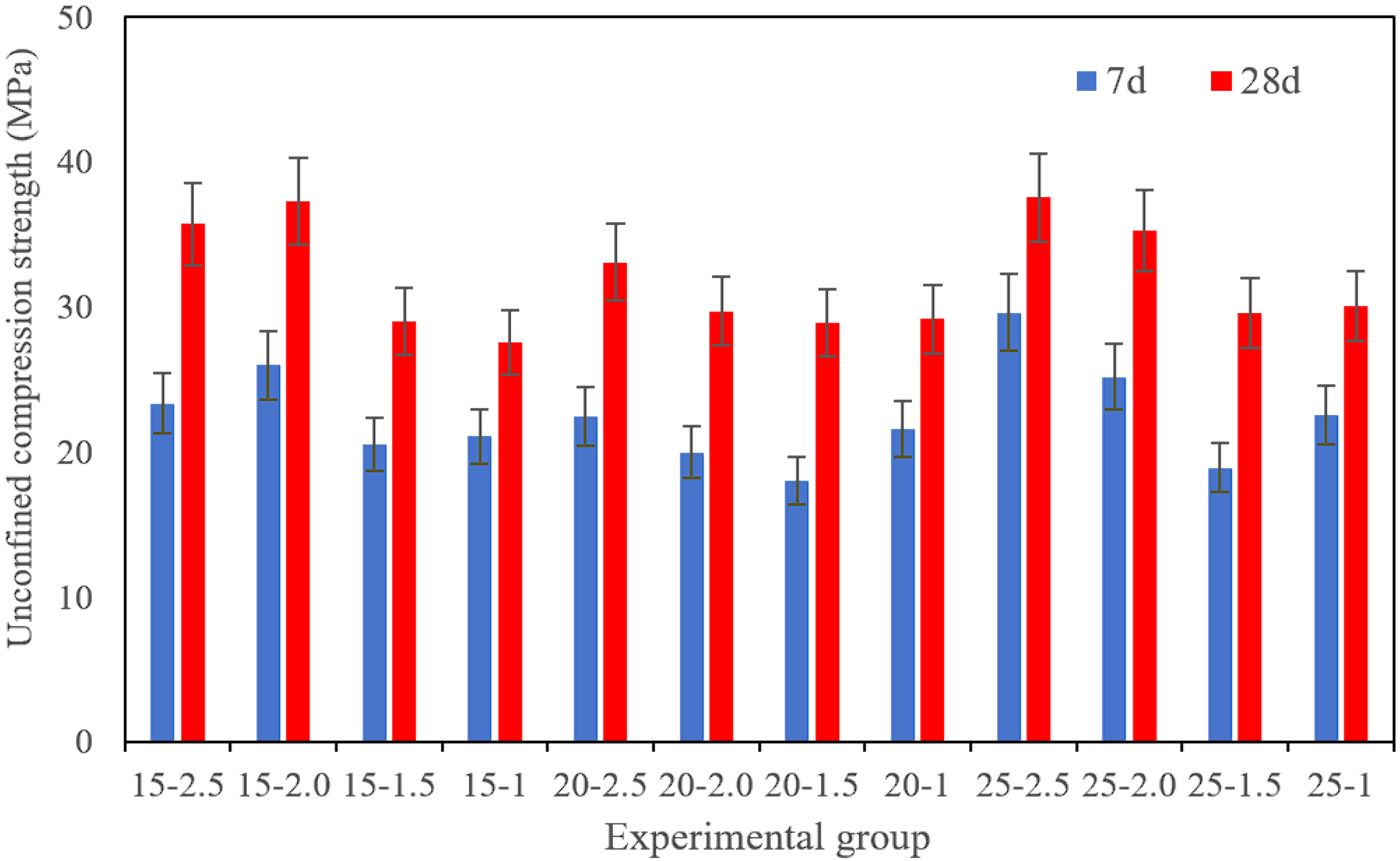
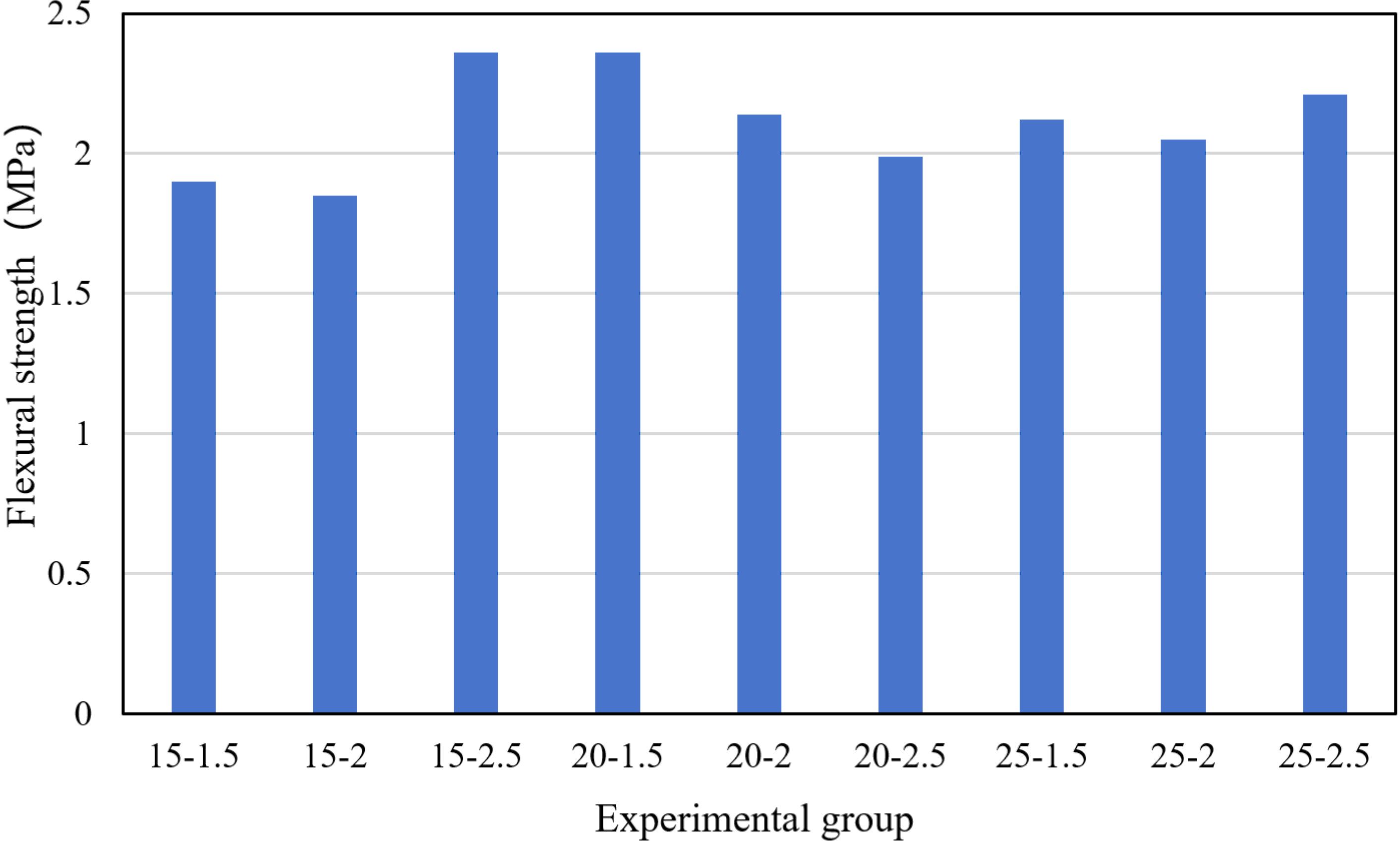
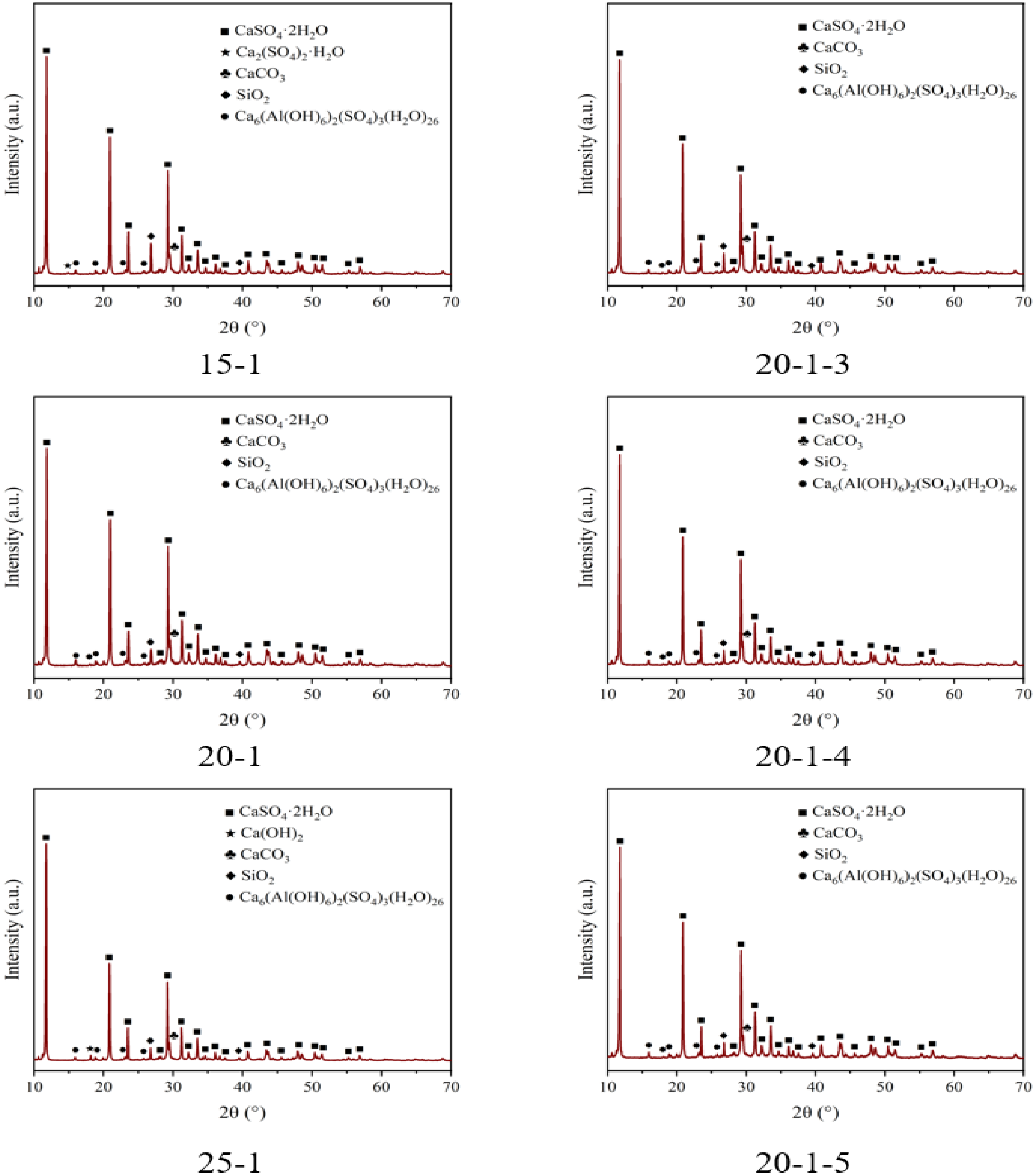
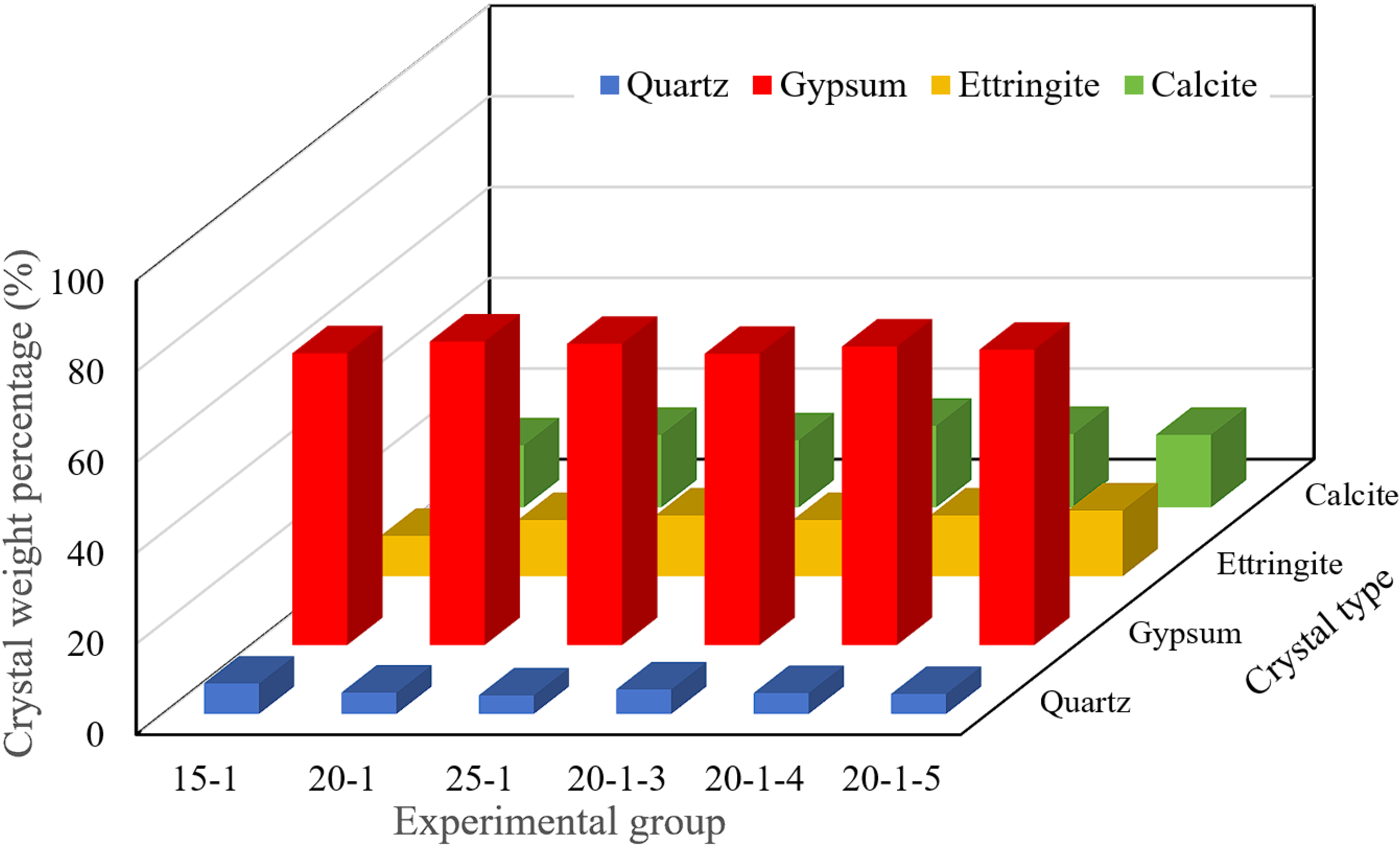
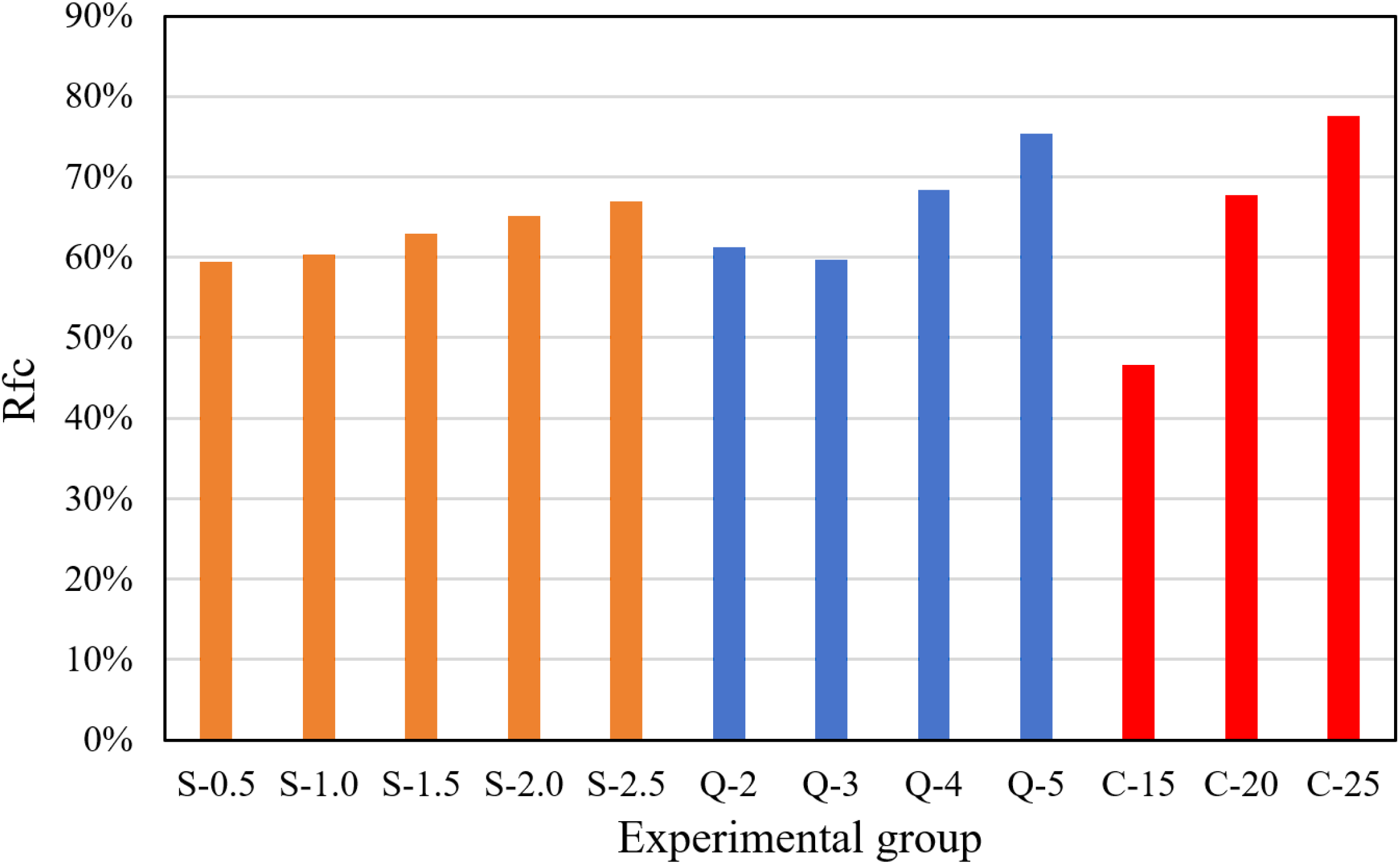
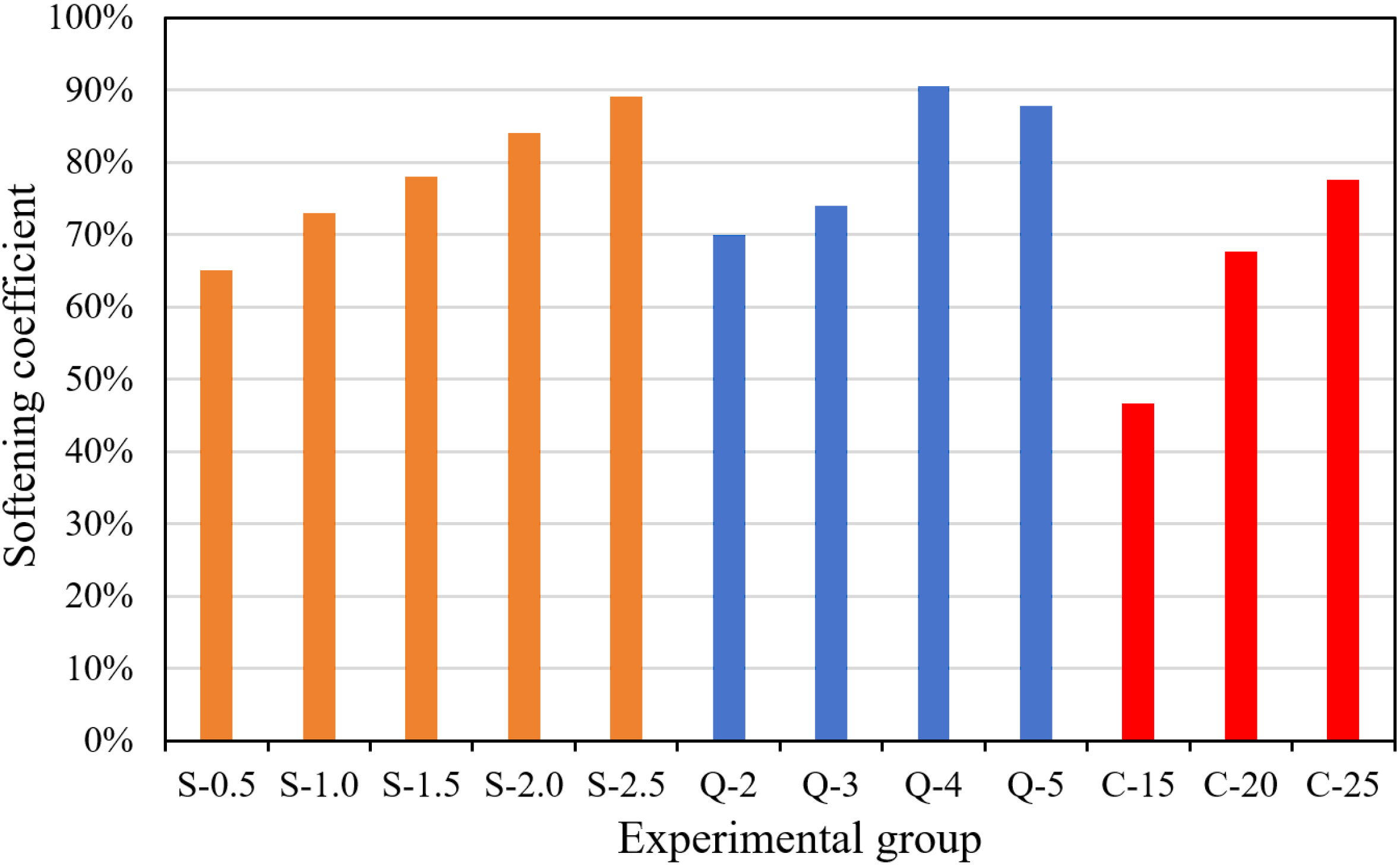
| Sieve Size (mm) | Accumulated Screening Residue (%) | Particle Passing Percentage (%) |
|---|---|---|
| 0.15 | 0.0 | 100.0 |
| 0.075 | 1.9 | 98.1 |
| Indicator | Test Results | Standard Limit |
|---|---|---|
| Initial setting time/min | 220 | ≥45 |
| Final setting time/min | 420 | ≤600 |
| 3 d Compressive strength/MPa | 25.6 | ≥17.0 |
| 28 d Compressive strength/MPa | 46.8 | ≥42.5 |
| 3 d Flexural strength/MPa | 5.6 | ≥3.5 |
| 28 d Flexural strength/MPa | 7.8 | ≥6.5 |
| Fineness/% | 3.8 | ≤10.0 |
| Soundness | Adequate | Adequate |
| Property | Value | Standard Limit |
|---|---|---|
| Calcium content (%) | ≥92 | ≥90 |
| Sieve residue (≤0.9 mm, %) | ≤7 | 4.1 |
| Density (g/cm3) | 3.35 | 3.1–3.4 |
| Activity (Dimensionless) | 400 | - |
| Property | Test Result | Reference Value |
|---|---|---|
| Density (g/cm3) | 1.44 | - |
| pH value | 7.7 | ≥7.0 |
| Storage stability (Dimensionless) | Satisfied | 5 °C, 28 d, No crystallization |
| Soluble solid percentage (%) | 96.5 | ≥95 |
| Unconfined compressive strength (MPa, 7 d) | 3.5 | ≥2.5 |
| Unconfined compressive strength ratio (%, 7 d) | 148 | ≥120 |
| Moisture stability coefficient ratio (%, 7 d) | 115 | ≥105 |
| Experimental Group Label | Cement Content | Stabilizer Content | Quicklime Content |
|---|---|---|---|
| 15-1 | 15% | 1% | 2% |
| 15-1.5 | 15% | 1.5% | 2% |
| 15-2 | 15% | 2% | 2% |
| 15-2.5 | 15% | 2.5% | 2% |
| 20-1 | 20% | 1% | 2% |
| 20-1.5 | 20% | 1.5% | 2% |
| 20-2 | 20% | 2% | 2% |
| 20-2.5 | 20% | 2.5% | 2% |
| 25-1 | 25% | 1% | 2% |
| 25-1.5 | 25% | 1.5% | 2% |
| 25-2 | 25% | 2% | 2% |
| 25-2.5 | 25% | 2.5% | 2% |
| 20-1-3 | 20% | 1% | 3% |
| 20-1-4 | 20% | 1% | 4% |
| 20-1-5 | 20% | 1% | 5% |
| Test Group | Ion Type | Concentration of Ion (mg/L) |
|---|---|---|
| Original phosphogypsum | F− | 100.45 |
| PO43− | 139.21 | |
| Cl− | 20.63 | |
| SO42− | 2461.16 | |
| Phosphogypsum with 2% quicklime | F- | 15.31 |
| PO43− | - | |
| Cl− | - | |
| SO42− | 2125.13 |
Disclaimer/Publisher’s Note: The statements, opinions and data contained in all publications are solely those of the individual author(s) and contributor(s) and not of MDPI and/or the editor(s). MDPI and/or the editor(s) disclaim responsibility for any injury to people or property resulting from any ideas, methods, instructions or products referred to in the content. |
© 2025 by the authors. Licensee MDPI, Basel, Switzerland. This article is an open access article distributed under the terms and conditions of the Creative Commons Attribution (CC BY) license (https://creativecommons.org/licenses/by/4.0/).
Share and Cite
Xiang, H.; Dong, C.; Wu, H.; Hu, X.; Gao, B.; Fan, Z.; Wan, J.; Ma, Y.; Guan, H. Study on Harmless Treatment and Performance of Phosphogypsum-Based Inorganic Cementing Material. Infrastructures 2025, 10, 196. https://doi.org/10.3390/infrastructures10080196
Xiang H, Dong C, Wu H, Hu X, Gao B, Fan Z, Wan J, Ma Y, Guan H. Study on Harmless Treatment and Performance of Phosphogypsum-Based Inorganic Cementing Material. Infrastructures. 2025; 10(8):196. https://doi.org/10.3390/infrastructures10080196
Chicago/Turabian StyleXiang, Hui, Chenyang Dong, Hao Wu, Xiaodi Hu, Bo Gao, Zhiwei Fan, Jiuming Wan, Yuan Ma, and Hongtao Guan. 2025. "Study on Harmless Treatment and Performance of Phosphogypsum-Based Inorganic Cementing Material" Infrastructures 10, no. 8: 196. https://doi.org/10.3390/infrastructures10080196
APA StyleXiang, H., Dong, C., Wu, H., Hu, X., Gao, B., Fan, Z., Wan, J., Ma, Y., & Guan, H. (2025). Study on Harmless Treatment and Performance of Phosphogypsum-Based Inorganic Cementing Material. Infrastructures, 10(8), 196. https://doi.org/10.3390/infrastructures10080196






